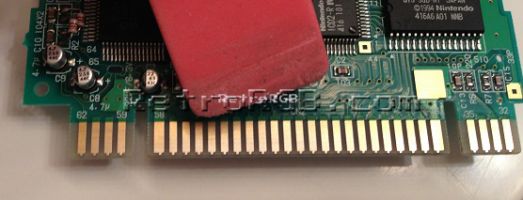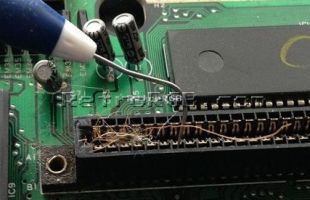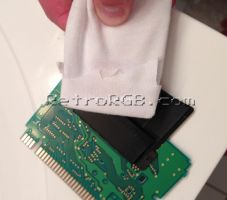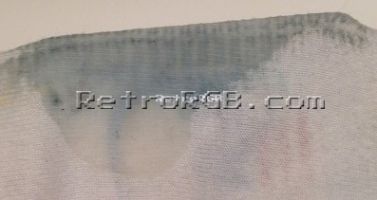Cartridge Cleaning: Difference between revisions
m (→Intro) |
(Fix typo and add clarification) |
||
| (5 intermediate revisions by 3 users not shown) | |||
| Line 1: | Line 1: | ||
{{ | {{warning|'''WARNING:''' Some sources online encourage the use of Brasso, sandpaper, or magic eraser on metal pins. This can potentially remove a layer of the metal (or the gold plating altogether) permanently damaging the pins, so it is not covered here.}} | ||
Over time, pins on cartridges and connectors can oxidize or receive dirt buildup and can prevent them from booting. It's also good practice to clean any games before trying them in your console, as this grime buildup can scrape off inside of your console and build up on the connector. This page details how to clean cartridges and connectors for any console, but with special considerations for some consoles listed at the bottom. | Over time, pins on cartridges and connectors can oxidize or receive dirt buildup and can prevent them from booting. It's also good practice to clean any games before trying them in your console, as this grime buildup can scrape off inside of your console and build up on the connector. This page details how to clean cartridges and connectors for any console, but with special considerations for some consoles listed at the bottom. | ||
= Blowing in | == Blowing in Games PSA== | ||
{{Warning|Blowing in your games can and does damage them!}} | {{Warning|Blowing in your games can and does damage them!}} | ||
The common practice of blowing into games only works because the constant reseating of pulling the game out and replacing it eventually creates a solid connection. The side effect of this is if saliva gets onto the connectors, it can cause corrosion and worsen the problem. This all being said, please don't blow in your games. | The common practice of blowing into games only works because the constant reseating of pulling the game out and replacing it eventually creates a solid connection. The side effect of this is if saliva gets onto the connectors, it can cause corrosion and worsen the problem. This all being said, please don't blow in your games. | ||
| Line 10: | Line 8: | ||
<youtube>https://www.youtube.com/watch?v=4Gf9mtXnJfM&t=296s</youtube> | <youtube>https://www.youtube.com/watch?v=4Gf9mtXnJfM&t=296s</youtube> | ||
==Items Needed== | |||
=Items Needed= | |||
:#Cotton Swabs | :#Cotton Swabs | ||
:#90% or greater | :#90% or greater isopropyl alcohol (IPA/rubbing alcohol) | ||
:#Lint free Cloth | :#Lint free Cloth | ||
:#Appropriate tool for opening cartridge. <small>(See console specific tools sections for more info)</small> | :#Appropriate tool for opening cartridge. <small>(See console specific tools sections for more info)</small> | ||
| Line 22: | Line 18: | ||
:#''(Optional)'' Soft bristle tooth brush | :#''(Optional)'' Soft bristle tooth brush | ||
== Cartridge Cleaning Directions == | |||
= Cartridge Cleaning Directions = | |||
:# If the cartridge can be opened and the PCB removed from the shell, the cleaning process will be much easier. Note that some games are more difficult to disassemble without damaging the shell (such as Atari 2600 and DS games). | :# If the cartridge can be opened and the PCB removed from the shell, the cleaning process will be much easier. Note that some games are more difficult to disassemble without damaging the shell (such as Atari 2600 and DS games). | ||
:# Take the alcohol and wet one end of the cotton swab. Apply moderate pressure with the wet end on the exposed pins and move it quickly from side to side, then like a toothbrush back and forth quickly on the pins. Flip the cart over and do the same with the pins on the other side. Once done, take the dry end of the cotton swab and do a once over to quickly dry and soak up any excess alcohol on the pins. Then proceed to the next step. | :# Take the alcohol and wet one end of the cotton swab. Apply moderate pressure with the wet end on the exposed pins and move it quickly from side to side, then like a toothbrush back and forth quickly on the pins. Flip the cart over and do the same with the pins on the other side. Once done, take the dry end of the cotton swab and do a once over to quickly dry and soak up any excess alcohol on the pins. Then proceed to the next step. | ||
| Line 35: | Line 29: | ||
[[File:CleaningCartridgeGames04.jpg|x200px]][[File:CleaningCartridgeGames06.jpg|x200px]] | [[File:CleaningCartridgeGames04.jpg|x200px]][[File:CleaningCartridgeGames06.jpg|x200px]] | ||
== Connector Cleaning Directions == | |||
= Connector Cleaning Directions = | |||
{{Warning|Ensure your console is powered off and unplugged before attempting this on any connector on the console.}} | {{Warning|Ensure your console is powered off and unplugged before attempting this on any connector on the console.}} | ||
:#Spray the pins with metal contact cleaner. | :#Spray the pins with metal contact cleaner. | ||
:#If the pins are accessible, gently scrub them with a cotton swab, soft-bristle toothbrush, or pipe cleaner. | :#If the pins are accessible, gently scrub them with a cotton swab, soft-bristle toothbrush, or pipe cleaner. | ||
== Cartridge Input Slot Cleaning Directions == | |||
= Cartridge Input Slot Cleaning Directions = | |||
{{Warning|Ensure your console is powered off and unplugged before attempting this procedure. Failure to remove power to the console can result in permanent damage.}} | {{Warning|Ensure your console is powered off and unplugged before attempting this procedure. Failure to remove power to the console can result in permanent damage.}} | ||
:#''(Highly recommended)'' Remove the console cover to allow easy access to the cartridge slot. | :#''(Highly recommended)'' Remove the console cover to allow easy access to the cartridge slot. | ||
| Line 57: | Line 46: | ||
[[File:CleaningCartridgeGames09.jpg|x200px]][[File:CleaningCartridgeGames10.jpg|x200px]][[File:CleaningCartridgeGames11.jpg|x200px]] | [[File:CleaningCartridgeGames09.jpg|x200px]][[File:CleaningCartridgeGames10.jpg|x200px]][[File:CleaningCartridgeGames11.jpg|x200px]] | ||
== Unfixable Games / Cartridge Slots (Extreme situations '''ONLY''') == | |||
= Unfixable Games / Cartridge Slots (Extreme situations '''ONLY''') = | |||
{{Warning|This procedure poses a risk of permanent damage to your cartridge or console. Use at your own risk.}} | {{Warning|This procedure poses a risk of permanent damage to your cartridge or console. Use at your own risk.}} | ||
In the most extreme scenarios, you can try using a fiberglass pen to remove any rust or damage to the cartridge pins. | In the most extreme scenarios, you can try using a fiberglass pen to remove any rust or damage to the cartridge pins. | ||
Be '''extremely''' careful, as this will remove both the rust, as well as a layer of the metal itself! Then, make sure to clean once more with an eraser and alcohol. | Be '''extremely''' careful, as this will remove both the rust, as well as a layer of the metal itself! Then, make sure to clean once more with an eraser and alcohol. | ||
== Special Considerations == | |||
= Special Considerations = | |||
=== Atari 2600 === | === Atari 2600 === | ||
Atari 2600 cartridges come in many shapes and sizes. Atari had no way of locking out third party developers and thus each publisher had their own cartridge shell. That should not be an issue as they can all be cleaned the same way. | Atari 2600 cartridges come in many shapes and sizes. Atari had no way of locking out third party developers and thus each publisher had their own cartridge shell. That should not be an issue as they can all be cleaned the same way. | ||
Check to see if the cart has exposed pins. If they are exposed, proceed to the cartridge cleaning directions. Most Atari and Sears published games have a spring-loaded dust shield that hides the pins until they are inserted into the console. To open it, put slight pressure on the bottom dust protector and wedge a toothpick or paper clip into one of the two slit like holes on either side of the dust protector. If done while slight pressure is applied, it should depress the dust protector. Repeat for the other side until you can push the dust protector all the way back. Then hold it there and proceed to the cartridge cleaning directions. | Check to see if the cart has exposed pins. If they are exposed, proceed to the cartridge cleaning directions. Most Atari and Sears published games have a spring-loaded dust shield that hides the pins until they are inserted into the console. To open it, put slight pressure on the bottom dust protector and wedge a toothpick or paper clip into one of the two slit like holes on either side of the dust protector. If done while slight pressure is applied, it should depress the dust protector. Repeat for the other side until you can push the dust protector all the way back. Then hold it there and proceed to the cartridge cleaning directions. | ||
[[Category:WonderSwan]] | |||
Latest revision as of 00:47, 8 September 2023
| WARNING: Some sources online encourage the use of Brasso, sandpaper, or magic eraser on metal pins. This can potentially remove a layer of the metal (or the gold plating altogether) permanently damaging the pins, so it is not covered here. |
Over time, pins on cartridges and connectors can oxidize or receive dirt buildup and can prevent them from booting. It's also good practice to clean any games before trying them in your console, as this grime buildup can scrape off inside of your console and build up on the connector. This page details how to clean cartridges and connectors for any console, but with special considerations for some consoles listed at the bottom.
Blowing in Games PSA
| Blowing in your games can and does damage them! |
The common practice of blowing into games only works because the constant reseating of pulling the game out and replacing it eventually creates a solid connection. The side effect of this is if saliva gets onto the connectors, it can cause corrosion and worsen the problem. This all being said, please don't blow in your games.
Items Needed
- Cotton Swabs
- 90% or greater isopropyl alcohol (IPA/rubbing alcohol)
- Lint free Cloth
- Appropriate tool for opening cartridge. (See console specific tools sections for more info)
- (Optional) Needle, Dental Pick, Weeding tool.
- (Optional) Metal Contact Cleaner (Such as CRC QD Contact Cleaner)
- (Highly Encouraged) Pink Eraser
- (Optional) Soft bristle tooth brush
Cartridge Cleaning Directions
- If the cartridge can be opened and the PCB removed from the shell, the cleaning process will be much easier. Note that some games are more difficult to disassemble without damaging the shell (such as Atari 2600 and DS games).
- Take the alcohol and wet one end of the cotton swab. Apply moderate pressure with the wet end on the exposed pins and move it quickly from side to side, then like a toothbrush back and forth quickly on the pins. Flip the cart over and do the same with the pins on the other side. Once done, take the dry end of the cotton swab and do a once over to quickly dry and soak up any excess alcohol on the pins. Then proceed to the next step.
- Test the cartridge. Make sure to test the following factors. If any issues are present, repeat the cleaning process. If repeating the process does not work, proceed to the next step.
- The game boots right away.
- The video is present and not glitching.
- The sound is present and not glitching.
- (Optional) Spray the pins with metal contact cleaner and scrub them with a cotton swab. Allow it to fully dry before testing.
- (Highly encouraged) Slice half of an eraser sandwich style so you have a flat eraser nub on one end. Place the flat end between the pins and the cartridge case while applying moderate pressure on the pins. Move the eraser back and forth and up and down quickly on the pins on each side, then take a cotton swab dipped in IPA and make sure all debris is wiped clean from the cartridge. Test the cartridge again.
Connector Cleaning Directions
| Ensure your console is powered off and unplugged before attempting this on any connector on the console. |
- Spray the pins with metal contact cleaner.
- If the pins are accessible, gently scrub them with a cotton swab, soft-bristle toothbrush, or pipe cleaner.
Cartridge Input Slot Cleaning Directions
| Ensure your console is powered off and unplugged before attempting this procedure. Failure to remove power to the console can result in permanent damage. |
- (Highly recommended) Remove the console cover to allow easy access to the cartridge slot.
- Inspect the slot for any foreign debris.
- Carefully remove any debris that is found using a needle or dental pick.
- Spray compressed air into the cartridge slot to remove any loose debris that was not removed in the previous step.
- Apply IPA to a terry cloth, lint free cloth, and wrap it around a credit card.
- Carefully insert the credit card with IPA soaked rag into the cartridge slot multiple times. Repeat this step until the cloth comes out mostly clean.
- (Optional) Spray contact cleaner into cartridge slot.
- Spray compressed air into the slot one more time to remove any excess IPA or contact cleaner.
Unfixable Games / Cartridge Slots (Extreme situations ONLY)
| This procedure poses a risk of permanent damage to your cartridge or console. Use at your own risk. |
In the most extreme scenarios, you can try using a fiberglass pen to remove any rust or damage to the cartridge pins.
Be extremely careful, as this will remove both the rust, as well as a layer of the metal itself! Then, make sure to clean once more with an eraser and alcohol.
Special Considerations
Atari 2600
Atari 2600 cartridges come in many shapes and sizes. Atari had no way of locking out third party developers and thus each publisher had their own cartridge shell. That should not be an issue as they can all be cleaned the same way.
Check to see if the cart has exposed pins. If they are exposed, proceed to the cartridge cleaning directions. Most Atari and Sears published games have a spring-loaded dust shield that hides the pins until they are inserted into the console. To open it, put slight pressure on the bottom dust protector and wedge a toothpick or paper clip into one of the two slit like holes on either side of the dust protector. If done while slight pressure is applied, it should depress the dust protector. Repeat for the other side until you can push the dust protector all the way back. Then hold it there and proceed to the cartridge cleaning directions.




